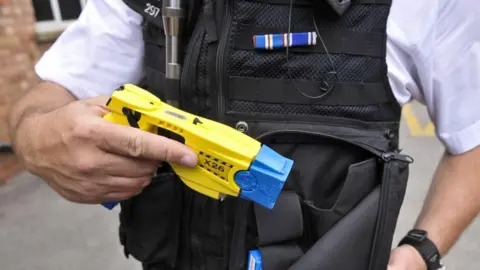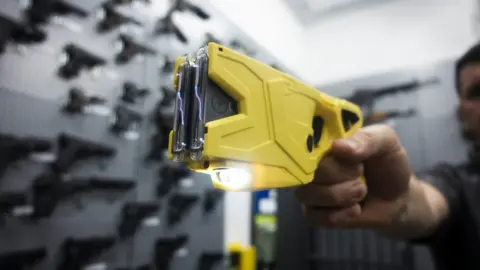Should all frontline police officers use Tasers?
 PA Media
PA MediaIf you're a police officer, your chance of being equipped with a Taser depends on your force.
Earlier this week, Northamptonshire Police announced it will be the first force in the country to arm all of its frontline officers with the electric stun guns.
Days later it was joined by a second force, Durham Constabulary, which said every frontline officer who wants a Taser will undergo training.
Although the decision to issue Tasers is a matter for each individual force, there are calls for the Home Office to fund training for all frontline officers.
But the issue is controversial, with several deaths linked to the weapons.
What are Tasers?
Conductive Energy Devices (CEDs) are known by their brand name, Tasers.
They fire two small dart-like electrodes before delivering a high-voltage shock to temporarily disable a suspect. This allows officers to deal with violent or potentially violent people at a distance.
They were introduced in the UK in 2003 for firearms officers. In 2007 they were extended to non-firearms officers known as Specially Trained Officers (STO).
In England and Wales, there are currently around 17,000 Taser-trained police out of 123,000 officers.
Several police forces, including South Wales Police, have doubled the amount of officers who are Taser trained in recent years but say they will not train all staff.
According to Home Office figures, they were used in 17,100 incidents in the year to March 2018, up from 11,300 the year before.
If an officer draws, aims and places a Taser red dot on the suspect, without harming them, the weapon is classed as "used" but not discharged. In 85% of the cases they were not discharged.
 PA Media
PA MediaTasers are an illegal weapon in the UK and members of the public who are found in possession of a Taser face up to 10 years in prison.
To be issued with a Taser, police officers must have completed 18 hours of training and are then required to undergo a compulsory refresher course every year.
What is the case for more officers using Tasers?
A recent Police Federation of England and Wales survey found 94% of officers think Tasers should be issued to more frontline staff.
Meanwhile, a petition demanding all police officers in the UK are issued with Tasers has garnered more than 95,000 signatures.
John Apter, national chair of the Police Federation, believes the Home Office should pay for all frontline officers to undergo the training - not the heads of each individual force.
The Independent reported that he asked Home Secretary Priti Patel to provide funding for frontline officers working across the country to undergo training.
He told the BBC: "Officers are telling me daily they are feeling vulnerable and often isolated due to the lack of this vital protective equipment.
"Ultimately, having a Taser gives them the capability to defend not only themselves but also the public they want to protect.
"This call for a wider rollout is not new; the federation has been fighting for many years for Tasers to be available to all colleagues who want to carry it and who pass the assessment."
Why are Tasers controversial?
But Taser use remains controversial since they were first introduced by forces in 2003.
According to Amnesty International, 18 people in the UK have died after a Taser was discharged against them by police since Tasers were introduced 16 years ago.
An IPCC report tracked several of the subsequent inquests - none of which recorded Taser use as the cause of death. However, the report only covered cases up to 2012.
In 2015, a jury at the inquest of Jordan Begley, 23, delivered a narrative verdict concluding he died partly as a result of being "inappropriately and unreasonably" Tasered and restrained by Greater Manchester Police officers two years earlier.
The death of ex-footballer Dalian Atkinson in 2016, after he was shot with a Taser, sparked virulent debate about the use of the stun gun by police. However, an inquest is yet to take place and while the CPS continues to consider bringing criminal charges against officers, it remains unclear whether the Taser contributed to Atkinson's death.
A study by Cambridge University found that police officers visibly armed with Tasers used force 48% more often, and were more likely to be assaulted than those on unarmed shifts.
An experiment with City of London police found that, while rarely deployed, just the presence of Tasers lead to greater overall hostility in interactions between the police and public.
Amnesty says the public should "resist the drum-beat of calls for all police to carry a Taser."
Oliver Feeley-Sprague, Amnesty UK's police and security programme director, says: "We recognise that Tasers can play a part in modern policing and have been proven to be effective as a distance control weapon in response to threats of serious harm. However, using them is not risk-free.
"A large number of officers fail the Taser training course, either in the proficiency of using it or their judgement about when to use it. This demonstrates very clearly that a Taser is not suitable for every officer."
 Getty Images
Getty ImagesAdditionally, black people are three times more likely than white people to be involved in Taser incidents, Home Office figures disclosed to the BBC in 2015 suggest.
Numbers show Tasers were drawn, aimed or fired 38,000 times in England and Wales from 2010 to 2015.
But in more than 12% of those cases the Tasers were used against black people, who make up about 4% of the population.
What does the Home Office say?
A Home Office spokesman told the BBC: "We are working to ensure forces have the resources, tools and powers they need to keep people safe.
"Tasers are an important tactical option for officers facing violent situations, and it is for chief officers to determine the number of devices and specially trained officers they need."
Clarification: This article was updated on 28 August 2019 to add in details of inquest findings.
